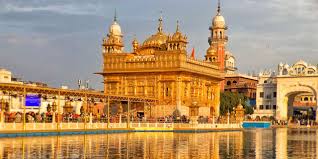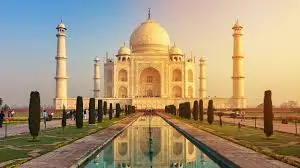The Golden Temple in Amritsar, Punjab, also known as Sri Harmandir Sahib, is a revered Sikh shrine renowned for its stunning gold-covered façade, spiritual significance, and welcoming langar tradition.
ADVERTIDEMENT

Table of Contents

Golden Temple (Amritsar, Punjab)
The Golden Temple, also known as Sri Harmandir Sahib, is the holiest and most iconic gurdwara in Sikhism, located in the city of Amritsar, Punjab. Built in the late 16th century by Guru Arjan Dev, the fifth Sikh Guru, the temple stands as a symbol of spirituality, equality, and humility. The structure’s crowning glory is its dome, covered in gold leaf, which glimmers beautifully against the serene waters of the Amrit Sarovar (holy tank) that surrounds it.
The temple is designed to be open to people of all religions and walks of life, emphasizing the Sikh principles of inclusivity and equality. Visitors enter the complex through four gates, symbolizing openness to all directions and faiths. The gurdwara houses the Guru Granth Sahib, the holy scripture of Sikhism, which is recited continuously as part of its spiritual practices.
One of the temple’s most cherished traditions is the langar, a free community meal served to thousands of visitors daily, irrespective of caste, creed, or religion. This tradition, started by Guru Nanak, embodies the spirit of selfless service and equality.
The Golden Temple’s architectural beauty is awe-inspiring, blending Mughal and Indian styles with intricate marble work, gold detailing, and a serene setting. At night, the reflection of the illuminated temple in the surrounding water creates a breathtaking view.
More than a place of worship, the Golden Temple is a symbol of peace, spirituality, and unity, drawing millions of pilgrims and tourists from around the globe. Visiting the Golden Temple is an experience that transcends religion, offering solace and inspiration to all who enter its sacred grounds.
I. Introduction
The Golden Temple, also known as Sri Harmandir Sahib, is the spiritual and cultural epicenter of Sikhism, located in the holy city of Amritsar, Punjab. This revered shrine is renowned not only for its religious significance but also for its stunning architectural beauty, featuring a glimmering gold-covered sanctum surrounded by the sacred Amrit Sarovar (holy tank).
The temple welcomes people of all faiths and walks of life, embodying the core Sikh principles of equality, humility, and selfless service. As a symbol of peace and unity, the Golden Temple attracts millions of pilgrims and tourists each year, making it one of India’s most cherished landmarks.
II. Historical Background
Foundation
The origins of the Golden Temple trace back to Guru Ram Das, the fourth Sikh Guru, who founded the city of Amritsar in 1577. He initiated the construction of the Amrit Sarovar, around which the temple was later built. The temple itself was completed by Guru Arjan Dev, the fifth Sikh Guru, in 1604.
Installation of Guru Granth Sahib
Guru Arjan Dev also installed the Adi Granth, the original version of the Sikh holy scripture, in the temple. This marked the Golden Temple as a spiritual hub for Sikhs, where the teachings of Sikhism were shared and preserved.
Reconstruction and Gold Plating
In the early 19th century, during the reign of Maharaja Ranjit Singh, the temple underwent significant renovation. The sanctum was gilded with gold, earning the temple its iconic name, the “Golden Temple.” This enhancement added to its beauty and grandeur, solidifying its reputation as a global architectural masterpiece.
III. Architectural Features
Gold-Plated Dome
The temple’s dome is covered in gold leaf, giving it a dazzling appearance that reflects the sun’s rays during the day and shines luminously at night. The dome’s design is inspired by both Mughal and Rajput styles, showcasing the harmonious fusion of architectural traditions.
Amrit Sarovar (Holy Tank)
The Golden Temple is surrounded by the Amrit Sarovar, a sacred pool believed to have healing properties. Pilgrims and visitors bathe in its waters as an act of purification and spiritual renewal. The serene pool also adds to the temple’s tranquil ambiance.
Harmandir Sahib (Sanctum)
At the heart of the complex lies the Harmandir Sahib, the sanctum that houses the Guru Granth Sahib, the holy scripture of Sikhism. The sanctum is adorned with intricate marble inlays and precious stones, further enhancing its divine aura.
Entrances
The temple complex has four gates, symbolizing openness to all people regardless of caste, creed, or religion. This architectural design emphasizes the Sikh value of inclusivity.
Blend of Styles
The architecture of the Golden Temple is a seamless blend of Mughal and Indian elements, with its intricate marble work, delicate frescoes, and gold detailing creating an awe-inspiring structure. The surrounding marble walkways and colonnades add to the grandeur of the complex.
IV. Spiritual and Cultural Significance
Universal Appeal
The Golden Temple is not limited to Sikh devotees; it is open to people of all faiths, emphasizing the Sikh principle of universal brotherhood and equality. The temple represents a spiritual sanctuary for anyone seeking peace, solace, and divine inspiration.
Equality and Service
The Golden Temple exemplifies the Sikh values of seva (selfless service) and equality. All visitors are treated equally, regardless of their social or economic background, and are encouraged to participate in communal activities.
Langar Tradition
One of the most remarkable features of the temple is the langar, or community kitchen, which serves free meals to thousands of visitors daily. The langar is prepared and served by volunteers, embodying the spirit of selfless service and emphasizing the Sikh belief in equality and humility.
V. Religious Practices and Experience
Continuous Recitation
Inside the sanctum, the Guru Granth Sahib is recited continuously, creating a serene and meditative atmosphere. Devotees gather to listen to these hymns, seeking spiritual guidance and inner peace.
Ceremonies
The daily rituals at the Golden Temple include the Prakash Ceremony (opening ritual) and the Sukhasan Ceremony (closing ritual), where the Guru Granth Sahib is ceremonially placed in its designated resting place.
Pilgrimage
For Sikhs, visiting the Golden Temple is a deeply spiritual experience. Pilgrims often make the journey to Amritsar to seek blessings, offer prayers, and immerse themselves in the sacred environment.
VI. Tourism and Legacy
Global Attraction
The Golden Temple is one of India’s most visited landmarks, drawing millions of tourists and pilgrims from around the world. Its serene atmosphere, combined with its rich history and architectural splendor, makes it a bucket-list destination for travelers.
Breathtaking Night View
At night, the temple is illuminated, and its reflection in the Amrit Sarovar creates a breathtaking sight. This visual spectacle adds to the temple’s allure, making it a photographer’s paradise.
Nearby Attractions
The Golden Temple is part of a larger cultural and historical landscape. Nearby attractions include:
- Akal Takht: The highest seat of authority in Sikhism.
- Jallianwala Bagh: A memorial for those who lost their lives in the 1919 massacre.
- Partition Museum: Chronicling the history and impact of India’s partition in 1947.
VII. Challenges and Preservation
Preservation Issues
The Golden Temple faces challenges such as pollution, urbanization, and the impact of heavy tourist footfall. The Amrit Sarovar requires regular cleaning to maintain its sanctity, and the gold plating needs periodic restoration.
Conservation Efforts
The Sikh community, along with authorities, actively undertakes preservation efforts to ensure the temple’s longevity. These include the maintenance of its gold plating, the restoration of marble inlays, and the promotion of eco-friendly practices within the temple complex.
Promotion of Sustainable Tourism
Efforts are being made to manage the growing number of visitors responsibly. This includes crowd control measures and awareness campaigns to encourage respect for the temple’s sanctity.
VIII. Conclusion
The Golden Temple is more than a place of worship; it is a symbol of unity, peace, and selflessness. Its awe-inspiring architecture, spiritual significance, and enduring traditions make it a beacon of hope and inclusivity for people around the world.
Visiting the Golden Temple offers not only a glimpse into the rich history and culture of Sikhism but also an opportunity to experience a profound sense of spiritual connection. It stands as a timeless reminder of the values of equality, service, and devotion, ensuring its place as one of India’s most treasured landmarks.

